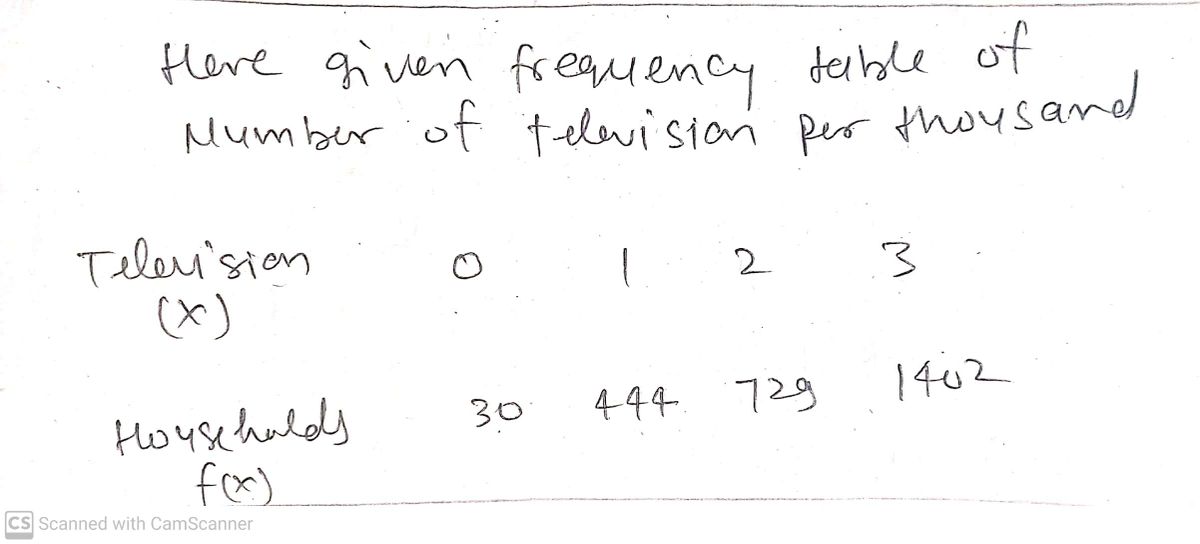A frequency distribution is shown below. Complete parts (a) through (d). The number of televisions per household in a small town Televisions 0 1 2 3 Households 30 444 729 1402 2 0.353
A frequency distribution is shown below. Complete parts (a) through (d). The number of televisions per household in a small town Televisions 0 1 2 3 Households 30 444 729 1402 2 0.353
A First Course in Probability (10th Edition)
10th Edition
ISBN:9780134753119
Author:Sheldon Ross
Publisher:Sheldon Ross
Chapter1: Combinatorial Analysis
Section: Chapter Questions
Problem 1.1P: a. How many different 7-place license plates are possible if the first 2 places are for letters and...
Related questions
Question
I am having a hard time trying to understand this topic. My TI-84 calculator has stopped working and I'm having to figure this out by hand.

Transcribed Image Text:**Frequency Distribution in a Small Town**
A frequency distribution is presented below for the number of televisions per household in a small town.
| Televisions | Households |
|-------------|------------|
| 0 | 30 |
| 1 | 444 |
| 2 | 729 |
| 3 | 1402 |
**Tasks:**
(a) **Probability Table**
- Probability for 2 televisions: 0.353
- Probability for 3 televisions: 0.679
- (Round probabilities to the nearest thousandth as needed.)
(b) **Mean of the Probability Distribution**
- Mean (μ) = 2.9 (Round to the nearest tenth as needed.)
**Additional Calculations:**
- **Variance (σ²) of the Probability Distribution:**
- Calculation is required (Round to the nearest tenth as needed.)
- **Standard Deviation (σ) of the Probability Distribution:**
- Calculation is required (Round to the nearest tenth as needed.)
This information can help to understand the distribution and average number of televisions per household, alongside variability within the surveyed households.
![### Understanding Frequency and Probability Distributions
The following data represents the number of televisions per household in a small town:
| Televisions | Households |
|-------------|------------|
| 0 | 30 |
| 1 | 444 |
| 2 | 729 |
| 3 | 1402 |
#### (a) Constructing a Probability Distribution
Using the frequency distribution, we can create a probability distribution as follows:
| x | P(x) |
|---|-------|
| 0 | 0.012 |
| 1 | 0.170 |
| 2 | 0.353 |
| 3 | 0.679 |
*(Note: Probabilities are rounded to the nearest thousandth.)*
#### (b) Calculating the Mean of the Probability Distribution
To find the mean (μ) of the probability distribution:
\[ \mu = 2.9 \]
*(Rounded to the nearest tenth as needed.)*
#### Calculating the Variance of the Probability Distribution
The variance (σ²) is also calculated but is not visible in this image. However, it typically follows the formula for variance of a probability distribution:
\[ \sigma^2 = \sum [x^2 \cdot P(x)] - \mu^2 \]
### Explanation
The data shows that most households have 3 televisions, as indicated by the largest number in the frequency table (1402 households). The probability distribution provides a view of the likelihood of each possible outcome, with the highest probability (0.679) being for 3 televisions per household. The mean gives an average of about 2.9 televisions per household.](/v2/_next/image?url=https%3A%2F%2Fcontent.bartleby.com%2Fqna-images%2Fquestion%2Fa212cf63-9018-4e31-a5dd-8ae3945d3a65%2F22bfb8b8-edcc-4671-af89-667a2501c2dc%2Fdqwxah_processed.jpeg&w=3840&q=75)
Transcribed Image Text:### Understanding Frequency and Probability Distributions
The following data represents the number of televisions per household in a small town:
| Televisions | Households |
|-------------|------------|
| 0 | 30 |
| 1 | 444 |
| 2 | 729 |
| 3 | 1402 |
#### (a) Constructing a Probability Distribution
Using the frequency distribution, we can create a probability distribution as follows:
| x | P(x) |
|---|-------|
| 0 | 0.012 |
| 1 | 0.170 |
| 2 | 0.353 |
| 3 | 0.679 |
*(Note: Probabilities are rounded to the nearest thousandth.)*
#### (b) Calculating the Mean of the Probability Distribution
To find the mean (μ) of the probability distribution:
\[ \mu = 2.9 \]
*(Rounded to the nearest tenth as needed.)*
#### Calculating the Variance of the Probability Distribution
The variance (σ²) is also calculated but is not visible in this image. However, it typically follows the formula for variance of a probability distribution:
\[ \sigma^2 = \sum [x^2 \cdot P(x)] - \mu^2 \]
### Explanation
The data shows that most households have 3 televisions, as indicated by the largest number in the frequency table (1402 households). The probability distribution provides a view of the likelihood of each possible outcome, with the highest probability (0.679) being for 3 televisions per household. The mean gives an average of about 2.9 televisions per household.
Expert Solution
Step 1

Step by step
Solved in 3 steps with 3 images

Recommended textbooks for you

A First Course in Probability (10th Edition)
Probability
ISBN:
9780134753119
Author:
Sheldon Ross
Publisher:
PEARSON


A First Course in Probability (10th Edition)
Probability
ISBN:
9780134753119
Author:
Sheldon Ross
Publisher:
PEARSON
